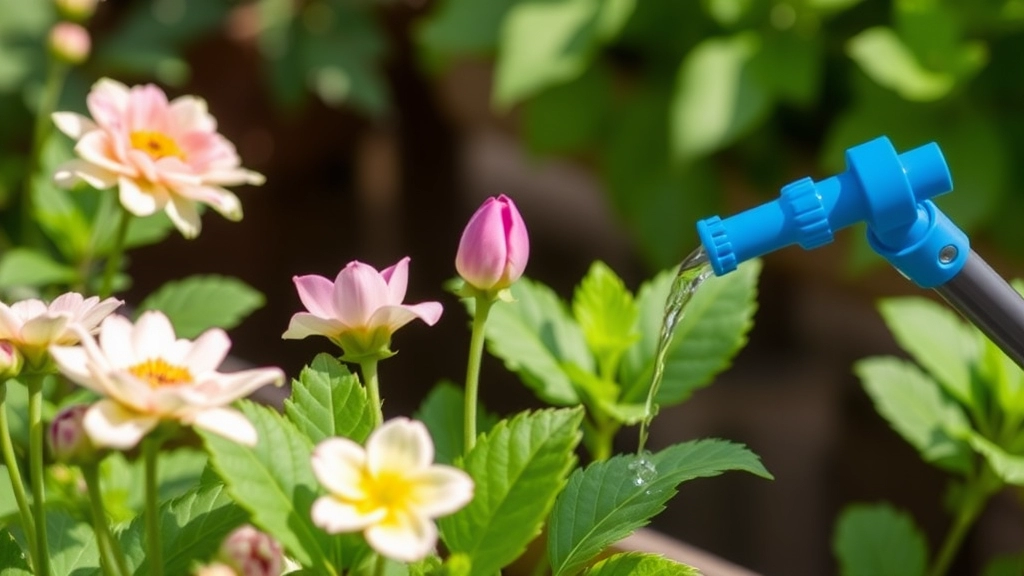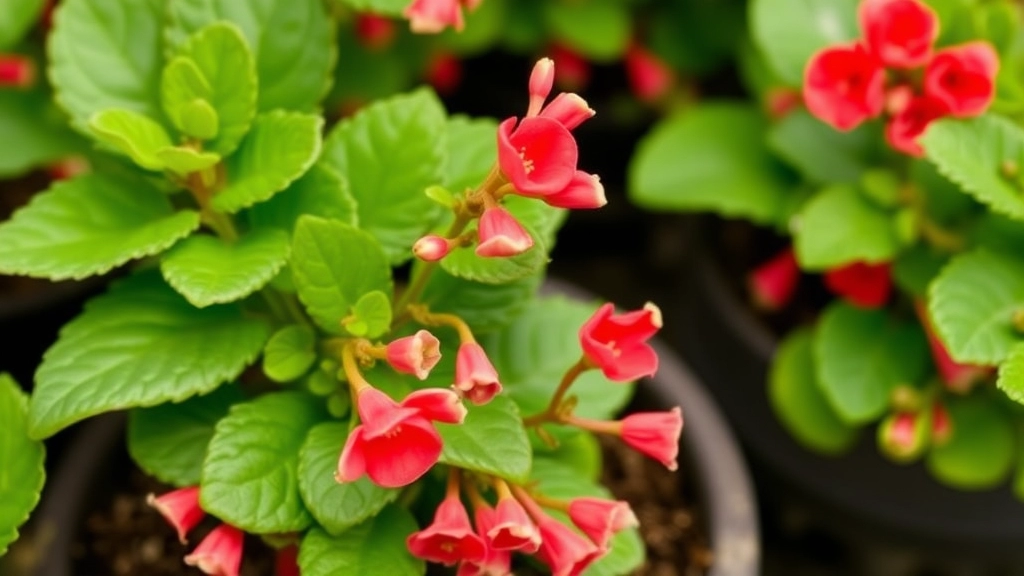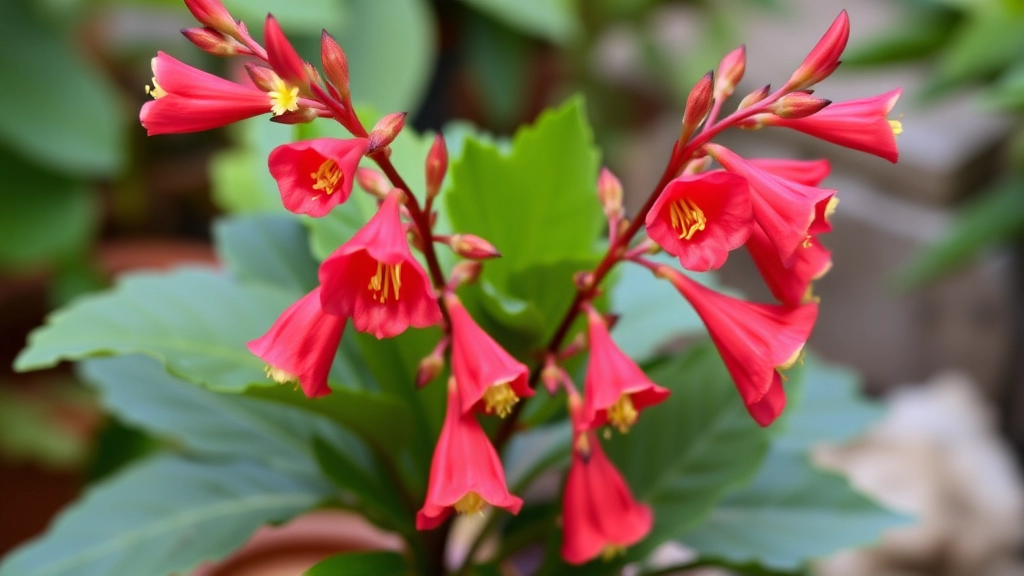Kalanchoe Red Bells: A Gardener’s Guide
If you’re a gardening enthusiast or houseplant lover, you’ve likely come across the stunning Kalanchoe Red Bells. With its vibrant red, bell-shaped flowers, this succulent is not only eye-catching but also relatively low-maintenance. In this guide, we’ll delve into the optimal growing conditions, watering and fertilization needs, and light requirements to help your Kalanchoe Red Bells thrive.
Understanding the best soil types and how to prevent common pests and diseases is crucial for maintaining healthy blooms. We’ll also cover propagation techniques and offer decorative uses and placement ideas to enhance your home with this unique plant. Dive in to discover everything you need to know about growing and caring for Kalanchoe Red Bells.
Optimal Growing Conditions for Kalanchoe Red Bells
Are you struggling to get your Kalanchoe Red Bells to thrive?
Understanding their optimal growing conditions is key to ensuring these vibrant plants flourish.
Ideal Temperature Range
Kalanchoe Red Bells prefer a warm environment.
- Temperature: Aim for 20-25°C (68-77°F) during the day and slightly cooler at night.
- Avoid Frost: These plants are sensitive to cold; temperatures below 10°C (50°F) can be detrimental.
Humidity Levels
Humidity plays a role in the health of your Kalanchoe.
- Moderate Humidity: They thrive in moderate humidity levels, around 40-60%.
- Avoid Excess Moisture: Too much humidity can lead to fungal issues.
Air Circulation
Good air circulation is essential for preventing pests and diseases.
- Ventilation: Ensure your plants are in a well-ventilated area.
- Avoid Stagnation: Stagnant air can promote mold and pests.
Container Selection
Choosing the right pot can make all the difference.
- Drainage: Use pots with drainage holes to prevent waterlogging.
- Size: A pot that’s too large can retain excess moisture, which Kalanchoe dislikes.
For more detailed care tips, check out our Outdoor Kalanchoe Care Guide and our Expert Tips on Caring for Kalanchoe Succulents.
Watering and Fertilization Needs for Healthy Blooms

So, you’ve got your Kalanchoe Red Bells, and now you’re wondering how to keep them blooming beautifully, right? Watering and fertilizing these vibrant plants is key to making sure they thrive.
Watering Tips
- Frequency: Water your Kalanchoe when the top inch of soil feels dry. This usually means every 1-2 weeks, depending on the season.
- Method: When you water, do it thoroughly. Let the water drain out of the bottom of the pot. This ensures the roots get enough moisture without sitting in soggy soil.
- Signs of Overwatering: Yellowing leaves or wilting can be signs you’re giving them too much water.
- Signs of Underwatering: If the leaves look shriveled or are dropping, it’s time to give them a drink!
Fertilization Needs
- Type of Fertilizer: Use a balanced, water-soluble fertilizer. Something like a 20-20-20 mix works wonders.
- Frequency: Feed your Kalanchoe every 4-6 weeks during the growing season (spring and summer). Cut back in the fall and winter when they’re resting.
- Dilution: Always dilute the fertilizer to half the recommended strength. This prevents any potential burn to the roots.
- Signs of Nutrient Deficiency: If the blooms are sparse or the leaves are pale, it might be time to step up your fertilization game.
When it comes to nurturing Kalanchoe Red Bells, one of the most pressing concerns is ensuring they receive the right amount of light. Many plant enthusiasts wonder why their Kalanchoe isn’t blooming as expected. The answer often lies in their light exposure.
Kalanchoe Red Bells thrive in bright, indirect sunlight. Here are some key points to consider:
– **Optimal Light Exposure**: Aim for at least 6 hours of bright, indirect sunlight daily. A south-facing window is ideal.
– **Avoid Direct Sunlight**: While they enjoy light, too much direct sunlight can scorch the leaves. If you notice yellowing or wilting, it may be a sign of sunburn.
– **Seasonal Adjustments**: During the winter months, you may need to rotate your plant to ensure even light distribution, as the sun’s angle changes.
– **Artificial Lighting**: If natural light is limited, consider using grow lights. These can provide the necessary spectrum for healthy growth and flowering.
– **Signs of Insufficient Light**: If your Kalanchoe is stretching towards the light or producing fewer flowers, it may not be receiving enough light.
By ensuring your Kalanchoe Red Bells receive the right light conditions, you can encourage vibrant blooms and healthy growth. For more detailed information on how to care for your Kalanchoe succulent, you can refer to this [complete guide](https://planthq.org/caring-for-your-kalanchoe-succulent-a-complete-guide/). Additionally, if you’re dealing with post-flowering care, these [tips](https://planthq.org/postflowering-care-tips-for-kalanchoe/) can be incredibly helpful.
Best Soil Types for Kalanchoe Red Bells

When nurturing your Kalanchoe Red Bells, the right soil can make all the difference. Have you ever wondered why your plants aren’t thriving as they should? The answer often lies in the soil composition.
Optimal Soil Composition
Kalanchoe Red Bells prefer well-draining soil that mimics their natural habitat. Here are some ideal soil types to consider:
- Cactus Mix: Specifically designed for succulents, this mix provides excellent drainage.
- Potting Soil with Perlite: Adding perlite to regular potting soil enhances aeration and prevents water retention.
- Sandy Soil: A blend of sand and potting soil can also work well, ensuring that excess moisture drains away quickly.
pH Levels
Aim for a slightly acidic to neutral pH level, around 6.0 to 7.0. This range promotes optimal nutrient absorption, keeping your Kalanchoe healthy and vibrant.
Homemade Soil Mix
If you’re feeling adventurous, consider creating your own soil mix. A simple recipe includes:
- 2 parts potting soil
- 1 part perlite
- 1 part coarse sand
This combination will provide the drainage Kalanchoe Red Bells crave while retaining just enough moisture for healthy growth.
Importance of Drainage
Remember, Kalanchoe are susceptible to root rot if left in overly moist conditions. Ensure your pots have drainage holes to allow excess water to escape.
As we delve into the care of Kalanchoe Red Bells, it’s essential to address a common concern: pests and diseases. No plant is immune, and knowing how to identify and treat these issues can save your beloved blooms from unnecessary stress.
### Common Pests:
– **Aphids**
– Small, soft-bodied insects that suck sap from leaves.
– Look for curled leaves or sticky residue.
– **Treatment:** Use insecticidal soap or neem oil.
– **Mealybugs**
– White, cottony masses found in leaf axils.
– They weaken the plant by feeding on sap.
– **Treatment:** Dab them with a cotton swab soaked in alcohol.
– **Spider Mites**
– Tiny, spider-like pests that thrive in dry conditions.
– They create fine webbing on the undersides of leaves.
– **Treatment:** Increase humidity and use miticides if necessary.
– **Scale Insects**
– Hard, shell-like pests that attach to stems and leaves.
– They can cause yellowing and leaf drop.
– **Treatment:** Scrape them off with a soft brush or use horticultural oil.
### Common Diseases:
– **Root Rot**
– Caused by overwatering; roots turn brown and mushy.
– **Prevention:** Ensure well-draining soil and proper watering practices.
– **Treatment:** Remove affected roots and [repot in fresh soil](https://planthq.org/how-to-plant-kalanchoe-stepbystep-guide/).
– **Powdery Mildew**
– White, powdery fungus on leaves, often due to poor air circulation.
– **Prevention:** Space plants adequately and avoid overhead watering.
– **Treatment:** Use fungicides or a homemade solution of baking soda and water.
– **Leaf Spot**
– Dark spots on leaves, often caused by fungal infections.
– **Prevention:** Water at the base and avoid wetting foliage.
– **Treatment:** Remove affected leaves and apply fungicides as needed.
### Prevention Tips:
– Regularly inspect your Kalanchoe Red Bells for any signs of pests or diseases.
– Maintain proper watering techniques to prevent root rot.
– Ensure good air circulation around the plant to reduce the risk of fungal infections.
By staying vigilant and taking proactive measures, you can keep your Kalanchoe Red Bells thriving and beautiful. For more detailed care tips, check out this [complete care guide for Kalanchoe](https://planthq.org/complete-guide-to-growing-kalanchoe-mother-of-thousands/).
How to Propagate Kalanchoe Red Bells Successfully

So, you’re loving your Kalanchoe Red Bells and want more? You’re in luck! Propagating these beauties is easier than you might think.
Why Propagation?
Maybe you want to share with friends or fill your home with more of that vibrant colour. Whatever your reason, let’s dive into the simple steps to get you started.
Propagation Methods
- Leaf Cuttings
- Choose a healthy leaf from your plant.
- Cut it cleanly at the base.
- Allow it to dry for a day or two to form a callus.
- Place it in well-draining soil, water lightly, and keep it in a warm spot.
- Stem Cuttings
- Snip a healthy stem about 3-4 inches long.
- Remove the lower leaves, leaving a few at the top.
- Let it dry for a day, then plant it in soil.
- Water sparingly until roots develop.
- Offsets
- Look for small offsets or pups around the base of your plant.
- Gently separate them from the main plant.
- Replant them in their own pots with suitable soil.
Tips for Success
- Timing: Spring is the best time for propagation. The plant is waking up and ready to grow.
- Humidity: Keep the cuttings in a humid environment. A plastic bag over the pot can help.
- Patience: It might take a few weeks for roots to develop, so don’t rush it!
Decorative Uses and Placement Ideas for Kalanchoe Red Bells in Your Home
After ensuring your Kalanchoe Red Bells are thriving, it’s time to think about how to showcase their stunning blooms. Many people wonder how to best display these vibrant plants in their homes.
1. Ideal Locations for Display
Kalanchoe Red Bells can brighten various spaces. Here are some suggestions:
- Living Room: Place them on coffee tables or shelves to create a focal point.
- Windowsills: They thrive in bright light, making a sunny windowsill the perfect spot.
- Dining Table: Use them as centrepieces for a pop of colour during meals.
- Entryway: A welcoming touch for guests, they can be placed near the front door.
2. Complementary Decor
Pairing your Kalanchoe Red Bells with the right decor can enhance their beauty:
- Pot Selection: Choose pots that contrast with the plant’s vibrant blooms. Neutral colours like terracotta or white can make the reds stand out.
- Grouping: Cluster them with other plants of varying heights for a dynamic display.
- Seasonal Decor: Incorporate them into seasonal arrangements, such as placing them alongside autumn leaves or festive ornaments.
3. Creative Arrangements
Think outside the box with your plant arrangements:
- Hanging Baskets: Consider using hanging planters to save space and draw the eye upward.
- Wall Shelves: Create a vertical garden by placing Kalanchoe Red Bells on wall-mounted shelves.
- Terrariums: For a modern twist, use glass terrariums to house smaller Kalanchoe plants.
4. Indoor vs. Outdoor
Kalanchoe Red Bells can also thrive outdoors, provided conditions are suitable:
- Patio or Balcony: Brighten these spaces with pots or window boxes.
- Garden Borders: When planted in the garden, they can add a splash of colour along walkways.
FAQs about Kalanchoe Red Bells
How often should I water my Kalanchoe Red Bells?
Water your Kalanchoe when the top inch of soil feels dry. This usually means every 1-2 weeks, depending on the season.
What type of fertilizer should I use for Kalanchoe Red Bells?
Use a balanced, water-soluble fertilizer, such as a 20-20-20 mix. Always dilute it to half the recommended strength to avoid root burn.
What kind of soil is best for Kalanchoe Red Bells?
Kalanchoe Red Bells thrive in well-draining soil. Options include cactus mix, potting soil with added perlite, or a blend of sand and potting soil.
What pH level should the soil have for optimal growth?
Aim for a slightly acidic to neutral pH level, around 6.0 to 7.0, to promote optimal nutrient absorption.
How can I propagate Kalanchoe Red Bells?
You can propagate Kalanchoe Red Bells through leaf cuttings, stem cuttings, or offsets. Each method involves allowing the cuttings to dry before planting them in well-draining soil.
When is the best time to propagate Kalanchoe Red Bells?
Spring is the best time for propagation, as the plant is waking up and ready to grow.
What are the signs of overwatering and underwatering?
Overwatering can cause yellowing leaves or wilting, while underwatering can result in shriveled or dropping leaves.
How often should I fertilize my Kalanchoe Red Bells?
Feed your Kalanchoe every 4-6 weeks during the growing season (spring and summer). Reduce fertilization in the fall and winter when the plant is resting.
What are the signs of nutrient deficiency in Kalanchoe Red Bells?
If the blooms are sparse or the leaves are pale, it might be time to increase your fertilization frequency.
Why is drainage important for Kalanchoe Red Bells?
Kalanchoe Red Bells are susceptible to root rot if left in overly moist conditions. Ensure your pots have drainage holes to allow excess water to escape.
Can I create my own soil mix for Kalanchoe Red Bells?
Yes, you can create your own soil mix using 2 parts potting soil, 1 part perlite, and 1 part coarse sand to provide the drainage Kalanchoe Red Bells need.
What are some tips for successful propagation?
Ensure proper timing (spring), maintain humidity, and be patient as it might take a few weeks for roots to develop.
References
-
Kalanchoe Plant Care: How To Grow A Kalanchoe
-
Kalanchoe Succulent Plant Profile
-
Kalanchoe: How to Grow and Care for Kalanchoe Plants
